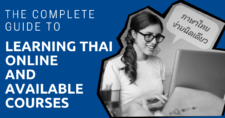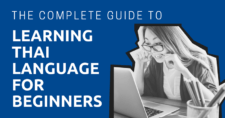
Hello, I’m Ben.
In 2017, I started a remarkable journey learning Thai after moving to Thailand. As someone who has had zero formal Thai language classes, I’ve made many mistakes along the way.
My adventure began in Tak, a traditional area with fewer foreigners than tourist hotspots like Chiang Mai or Bangkok. At first, speaking Thai and fitting in was tough. But with hard work and practice, I’ve improved a lot. I can tell you that learning Thai is possible — and you don’t even need to live in Thailand to learn it fast. There are a lot of resources out there.
By the end of this guide, you’ll know the tips, tricks, and resources that worked for me, and I’ll reveal the mistakes I made so you can get a head start. I’ll show you what I think is important, why it matters, and how it helped me learn Thai fast.
If you’re eager to know right away which tool accelerated my learning the most, it’s ThaiPod101 and ExpatDen’s Learn Thai Language resource page. These resources speed up the process, especially for memorizing the Thai alphabet, recognizing new words, and learning to read — all essential skills for mastering Thai.
Enter your email below to receive our FREE Thai Language Cheat Sheet. It includes a comprehensive list of downloadable PDFs to quickly get you started learning the Thai language. The Cheat Sheet covers everything, from the alphabet, tone marks, and consonant sounds to vocabulary and much more.
Disclaimer: This article may include links to products or services offered by ExpatDen's partners, which give us commissions when you click on them. Although this may influence how they appear in the text, we only recommend solutions that we would use in your situation. Read more in our Advertising Disclosure.
Contents
- Key Takeaways
- Why Should You Learn Thai?
- Thai: Harder and Easier Than You Think
- Step 1: Integrate Thai Into Your Daily Life
- Step 2: Learn to Read Thai
- Step 3: Learn to Pronounce Thai
- Step 4: Learn to Comprehend Thai
- Step 5: Build Your Thai Vocabulary
- Step 6: Take an Online Thai Language Course
- Step 7: Practice Thai in the Real World
- Best Way to Learn Thai Fast and for Free
- Additional Tips
- FAQs About Learning Thai Fast
- What are the Most Effective Methods for Learning Thai Quickly?
- How Can I Master Thai Tones Without Getting Confused?
- Are There Specific Apps or Resources that Accelerate Thai Language Learning?
- How Much Thai Vocabulary Should I Learn to Hold Basic Conversations?
- Can I Learn Thai in Three Months, and if so, How?
- What Common Mistakes Do Beginners Make When Learning Thai Quickly?
- How Can I Practice Speaking Thai Daily Without a Language Partner?
- Is it Better to Focus on Reading, Writing, or Speaking First in Thai?
- How Do I Stay Motivated When Learning a Complex Language Like Thai?
- What Cultural Aspects Should I Understand to Communicate More Effectively in Thai?
- What to Read Next
(And How It’s Costing Them)
Most expats throw money away, get lost in red tape, and miss the local hacks that make life easier and cheaper. ExpatDen Premium gives you the secrets seasoned expats use to save, earn, and thrive beyond the basics, saving you thousands and opening doors you didn’t even know existed.
Here’s what’s inside:
- Housing Hacks: Slash your rent by 40% or more - because the locals are laughing at what you’re paying.
- Banking Mastery: Stop wasting on fees and get top exchange rates. Why give your money away?
- Healthcare for Local Prices: Quality treatment without the expat price tag.
- Visa and Legal Shortcuts: No more bureaucratic nightmares. Get the visa and residency secrets that others pay their lawyer dearly for.
- Deep Discounts: Find the savings locals rely on for groceries, dining, and more.
If you’re serious about making Thailand work for you, join ExpatDen Premium and make Thailand work for you.
Key Takeaways
- Learn to read Thai first to understand phonetics and tones, speeding up overall language acquisition much faster than speaking-only approaches.
- Use ThaiPod101 or Learn Thai from a White Guy to address specific challenges and learn strategies for quick progress.
- Practice reading in real-world contexts by reading menus, signs, and product labels.
- Combine apps with human interaction for immediate feedback and motivation that’s needed to improve.
- Focus on sounds before perfecting Thai tones by mastering basic character recognition and phonetics first.
Why Should You Learn Thai?
Learning Thai opens doors that remain closed if you rely on English. Whether you’re planning a trip to Thailand or looking to move to the country long term, learning Thai will help you stand out.
- Cheaper prices: in many cases, you can avoid inflated foreigner prices just by speaking Thai. I’ve found that asking “Can you lower the price?” in Thai (lot raka dai mai/ลดราคาได้ไหม) gets you far better prices at markets and other places where people are willing to negotiate.
- Freedom to live: Many Thais can’t speak English. So if you can’t speak Thai, you’ll be stuck living in the popular and often overcrowded expat areas. But if you learn Thai, you can enjoy life everywhere in Thailand — no matter where you choose to travel or live.
- Job opportunities: Your chances of landing your ideal job increase the longer you stay in Thailand and the better you speak Thai. In fact, ExpatDen founder Karsten covers this in his book, “Working in Thailand.” I know many people who’ve increased their network due to their proficiency in Thai, and this has opened up many doors for them.
The rewards of learning Thai extend far beyond just ordering food or asking for directions. As you get better, you’ll find yourself thinking in new ways, understanding cultural perspectives that were invisible, and connecting with people on a level that would be impossible. Like I discovered in my journey, Thai isn’t just another language to learn — it’s a new lens through which to see Thailand and the rest of the world.

Thai: Harder and Easier Than You Think
Thai isn’t the easiest language in the world to learn, yet it isn’t the hardest. The U.S. Department of State ranks Thai as Category Three in difficulty — with four being the most challenging.
What does this ranking mean? Well, in theory, if you are a native English-speaking person who wants to become proficient enough in Thai to work in a professional setting where only Thai is used, you’d need 44 weeks of study, or 1,012 classroom hours.
That sounds like a lot of time, especially if you’re interested in learning Thai fast. But as you’ll see throughout this guide, they are faster ways to learn the language. But first, let’s look at what makes Thai both hard and easy to learn.
Why Thai is Hard
It may feel impossible to learn Thai from scratch, but believe me, it’s not. Anyone can do it, provided you put the effort in. I did it, and continue to do so, and I don’t consider myself a master of languages.
In my experience, here are the most difficult things about learning Thai:
- Thai tones: Thai has five distinct tones that change word meanings, making pronunciation challenging for speakers of non-tonal languages.
- Unknown script: The Thai alphabet has 44 consonants, 15 vowel symbols that combine into 28 vowel forms, and various tone marks, which might scare you away from reading.
- Different sentence structure: Thai follows a subject-verb-object pattern but has significant differences in word order, omitted subjects, and unique classifier system compared to English.
But I’m not here to scare you. I have some good news too. There are quite a few things that make the Thai language quite easy to learn.
Go Deeper: What is Thai Tone? Rules, Patterns, and How to Master It
Why Thai is Easy
Difficulties aside, I’ve found Thai to be easier to learn when compared to other languages. I’ll cover a few of these reasons below.
- Compounded vocabulary: Words combine to form new meanings (e.g., “naam/น้ำ” (water) + “pla/ปลา” (fish) = “naam pla/น้ำปลา” (fish sauce)).
- Limited vocabulary range: Fewer distinct words to learn compared to English, with basics combining to create new meanings.
- Simplified grammar: No conjugations, declensions, or inflections in Thai.
- No word form changes: Thai words remain the same regardless of gender, person, number, or tense. Time indicators are added separately.
- No articles: No equivalents for “a,” “an,” or “the,” with unnecessary words omitted.
One verb form only: Learn just one form per verb instead of dozens in languages like Spanish or French.
With both the hard and easy aspects of learning Thai covered, let’s talk about how you can set up an everyday routine that helps you learn Thai fast.
Step 1: Integrate Thai Into Your Daily Life
While I was in Tak, I found that incorporating Thai into my everyday routine sped up my learning process because I was exposed to Thai in practical ways. Fact is, by surrounding myself with Thai digitally and physically, I transformed passive moments into active learning.
You can use the following methods to do the same:
- Thai keyboard on your devices: Install Thai keyboard layouts on your phone, tablet, and laptop to practice typing in Thai when messaging friends, taking notes, or searching online.
- Thai language OCR tools: Use apps that can scan and translate Thai text from menus, signs, and documents, letting you decipher and learn from the materials you encounter.
- AI conversation partners: Practice speaking and listening with ChatGPT or other AI assistants. You can get 24/7 conversation practice and pronunciation feedback.
These technologies help you transform idle moments into chances to learn, creating a continuous Thai learning environment no matter where you are. Even brief daily practice with Thai text, audio, or conversation partners add up over time.
Step 2: Learn to Read Thai
Learning to read Thai accelerates overall language acquisition, despite common advice to focus on speaking first. My experience proves that reading provides the basis for faster progress in all language skills.
When I moved to rural northern Thailand knowing zero Thai (not even “hello”), I focused only on speaking and listening — a decision that slowed my progress. For six months, I struggled to retain pronunciation, tones, and vocabulary skills because my English-trained ear had, until then, never heard them.
Everything changed when I began learning to read Thai. Reading creates a crucial visual framework for understanding the phonetic elements that make Thai challenging. Without seeing the written language, many sounds remain the same to our ears, making both listening and pronunciation difficult.
The Thai writing system shows tones and distinct consonant sounds that are confused when only heard. By learning to read first, you get the complete sound system of Thai, allowing your brain to group and see patterns that remain hidden in spoken language alone.
Here are a few free online resources where you can practice reading Thai as it’s used in everyday life:
- r/thaithai subreddit: It might seem overwhelming at first, but browsing this popular subreddit for just 15 minutes a day will show you how the Thai vocabulary that you’re learning is used in context. As a bonus, you also get a glimpse into the world of Thailand’s newer generation, what they like, dislike, and so on, giving you plenty to talk about when practicing speaking Thai in the real world.
- University of Wisconsin at Madison: Thai professors at the university created a free Thai reader project with two volumes packed with practical Thai reading practice. Altogether, there are nearly 100 lessons available for you to download and practice with. Keep in mind these lessons aren’t for immediate beginners. But remember — the more exposure to Thai, the faster you learn.
Thai is a phonetic language; unlike Chinese or Japanese. If you can see, hear, and practice the sound of a letter singled out and alone, then you’re practicing your listening and speaking at the same time.
Plus, writing the symbol helped me retain the memory of the shape as it became a part of my muscle memory. I also wrote the symbols on a separate page at the back of my notebook with no notes. I then used this page to see if I could remember the sound of the symbol I was reading, using my notes to check my answers.
If you’re serious about learning Thai quickly, start with reading rather than focusing on speaking. This provides the most efficient path to overall fluency.
Go Deeper: The Complete Guide to Learning the Thai Alphabet
Step 3: Learn to Pronounce Thai
Mastering Thai pronunciation is crucial for you to be understood, and the unique phonetic challenges of Thai require practice. My struggles with tones and consonants improved once I developed a system for pronouncing Thai.
Just like it’s difficult for some Asian people to pronounce R’s and L’s in English, your accent will be very strong and difficult to understand for some Thais.
Some words will be muddled up when speaking if you don’t practice the phonemes first. Think of words like correct and collect, grass and glass, or fry and fly. It can be confusing for an English speaker to hear these words mixed up and pronounced.
You will do the same in Thai with sounds that cannot be spelled out using the Romanized alphabet. Learning to read is also learning to listen and speak the language, just in small steps, which is what you need in a difficult language like Thai.
So, work on the following:
- Master the five tones: Low, mid, high, falling, and rising tones are essential as they change word meanings — practice each tone pattern daily.
- Focus on consonant clusters: Thai contains sounds that don’t exist in English, like the aspirated “ph” or the unique “ng” initial sound.
- Use minimal pairs practice: Drill words that differ only by tone or similar-sounding consonants to train your ear and mouth.
- Record and compare yourself: Record your pronunciation, then compare it with native speakers to identify specific areas for improvement.
- Slow down: Pronounce words slowly at first to ensure you’re hitting the correct tones before attempting natural speech speed.
The mirror technique — watching your mouth movement while practicing difficult sounds — helped me with certain consonants that require specific tongue positions. Exaggerated hand movements to trace the tone contours while speaking reinforced the correct pitch patterns in my muscle memory.
Remember that perfect pronunciation isn’t required for speaking. Focus first on the tones and sounds that cause misunderstandings, and refine your accent as you progress. Thai speakers will appreciate your efforts even if your Thai isn’t clear yet.
Step 4: Learn to Comprehend Thai
Understanding spoken Thai becomes easier once you develop reading skills. The connection between written symbols and sounds creates a cognitive framework that helps your brain process and recognize spoken Thai more, even at natural speaking speeds.
Developing Thai listening comprehension happens as you progress:
- Reading builds familiarity with sound patterns and tones that appear in everyday speech.
- Audio lessons become more effective when you can visualize the written words as you listen.
- Recognizing tone marks in writing translates to better tone recognition in conversation.
- Common word combinations seen in writing become easier to identify when heard in rapid speech.
This reading-supported approach to listening creates a multi-sensory learning experience where visual and auditory processing reinforce each other, speeding up your ability to understand Thai in the real-world.
Step 5: Build Your Thai Vocabulary
Reading Thai while you go about your daily life expands your vocabulary through practical, memorable exposure. When you can read Thai, then menus, road signs, and product labels become language learning resources.
You can build real-world vocabulary in the following ways:
- Supermarket aisle signs: teach you food categories like “snacks” or “beverages” while you shop.
- Restaurant menus: reinforce essential food terms like “chicken” (ไก่) and “pork” (หมู) each time you order.
- Food cart signs: help you remember the names of dishes you enjoy, allowing you to order them again with confidence.
These everyday reading chances make routine activities into vocabulary-building exercises. You can learn new words through regular, meaningful exposure rather than just using books to learn Thai words you might never use.
Step 6: Take an Online Thai Language Course
Learning to read is important and it helps you to take baby steps to pronounce and recognize sounds in spoken language. But where do you start? And isn’t the process lengthy? Well, no. Not.
I learned to read in just one month. And you can too using one of these courses below.
ThaiPod101
ThaiPod101 offers a structured path to reading Thai through its in-depth courses. I started but achieved fluent reading within about a year, though you can progress faster with consistent practice.

It even offers a free resource section if you want to test the platform before joining. Here’s just some of what ThaiPod101 offers:
- Thai Alphabet Made Easy: 25 video lessons covering the complete Thai alphabet, vowels, and numbers.
- Structured learning approach: Watch just one to two lessons daily to learn reading and writing within weeks.
- Free trial strategy: Complete the entire reading course during the seven-day free trial.
- Supplement with YouTube: Begin with its free YouTube videos before starting your trial.
Here’s how to make those most out of your learning when take a course on ThaiPod101:
- Set your level: Choose “absolute beginner,” navigate to the “ultimate video getting started” section, and follow each lesson in sequence. This transformed my ability to navigate Thailand and can accelerate your Thai learning journey too.
- Practice daily: Just complete two or three lessons a day with the free videos to avoid burnout. Later, during your free trial, finish the Thai Alphabet Made Easy course.
- Take handwritten notes: Keep a notebook of characters, practice writing each several times.
- Create a revision page: Make a separate page of symbols for quick self-testing.
If you finish all of the ThaiPod101 main courses, you should be able to read Thai in your daily life.
Go Deeper: An In-Depth ThaiPod101 Review: Is it Go
Learn Thai from a White Guy
Learn Thai from a White Guy offers a structured learning system created by someone who overcame the same Thai language struggles that I and most foreigners face.
The program’s central philosophy — learning Thai script first — aligns with my philosophy that you need to read Thai to master it quickly.

- Script-first method: The course prioritizes teaching you how to read Thai before anything else, creating the foundation for faster overall progress.
- Practical sentence patterns: After building reading skills, the course transitions to common sentence structures you’ll use in daily life.
- Targeted problem solving: Lesson synopses address the specific challenges English speakers encounter when learning Thai.
- Beginner-friendly approach: The entire system is designed for complete beginners, with clear explanations that make complex concepts accessible.
- Free learning path: Works well as a starting point before transitioning to ThaiPod101’s intermediate and advanced content.
This program provides an excellent alternative learning path, especially if you prefer a more structured, reading-focused approach to Thai. The founder’s personal journey from struggling learner to fluent speaker informs a teaching method designed to overcome the roadblocks that slow down Western learners.
iTalki
iTalki connects you with professional Thai tutors online, speeding up your language learning through lessons that you customize.

ExpatDen editor John has been using italki to continue his Thai learning. What attracted him to the platform was the range of available tutors and the fact that he could book sessions when it was most convenient for him. Plus, he could tailor the lessons to his learning needs.
Here’s how he benefits from using iTalki:
- Immediate pronunciation correction: Tutors identify and fix tonal mistakes before incorrect habits form — crucial for Thai because tone changes meaning.
- Customized curriculum: Focus on what you need, whether that’s business Thai, casual speaking skills, or reading practice.
- Flexible scheduling: Book lessons that fit your schedule, with no commute or fixed class times.
- Diverse tutor options: Choose from hundreds of teachers with rates ranging from THB700 to THB4,000 per hour.
- Tailored levels: Find tutors who specialize in teaching your specific proficiency level, from complete beginner to advanced.
iTalkiallows you to review tutor profiles, teaching approaches, and student feedback before committing. Many tutors offer discounted trial lessons, giving you the opportunity to find the perfect teaching style without a major financial commitment.
Ling
Ling transforms Thai language learning into an engaging game-like experience, making it ideal for beginners looking for an easy way to start.
The app’s interactive approach motivates you through what can be a challenging learning phase.

- Gamified learning environment: Turns tedious aspects like memorizing the alphabet into enjoyable activities.
- Beginner content: Contains over 200 lessons covering fundamental Thai language concepts.
- Balanced skill development: Builds reading recognition, vocabulary skills, and basic sentence structures at the same time.
- Mobility and convenience: Learn in short sessions whenever you have a free moment.
- Low-pressure introduction: Creates a stress-free environment for complete beginners to familiarize themselves with Thai.
While Ling provides an excellent supplementary resource, serious learners should consider it as just one component of a deeper learning strategy. For committed progress, pair Ling with structured courses like ThaiPod101, professional instruction through iTalki, or formal language school training.
Go Deeper: Ling Learn Thai Language Review: Is it Worth It?
Step 7: Practice Thai in the Real World
While apps offer you a structured introduction, their ability to deliver the depth and authenticity of the real-world is limited. Therefore, you should use them as a starting point for real conversations — then practice in the real world.
This approach emphasizes using language in practical, real-world situations, encouraging learners to engage in meaningful conversations instead of just focusing on grammar and vocabulary drills. By doing this, you acquire Thai language skills and learn to communicate in many contexts.
- Express yourself in appropriate ways: Learn appropriate expressions and responses that apps rarely teach. Understand the nuances of polite speech, casual conversation, and formal language. Adapt your language to different situations and relationships. Recognize and use the body language that accompanies Thai speech.
- Understand language through real-world contexts: Absorb new vocabulary, idioms, and expressions in meaningful contexts. Experience Thai as it’s spoken, not just textbook versions. Develop real-time understanding and the skill to respond. Come across new words, building on what you know.
- Immerse yourself with native Thai speakers: Use Thai in markets, restaurants, transportation, and shops. Words and phrases stick when used in meaningful interactions. Get immediate, authentic responses while you talk. Cement important words through regular, practical usage.
- Find a language partner: Schedule regular conversations with a native Thai speaker. You can do this on italki. Consider a language exchange where you help with English in return. Make friends with Thais so you can continue learning. Focus on topics and vocabulary relevant to what interests you.
- Use non-verbal communication: Use pointing, hand movements, and facial expressions to enhance understanding. Show what you mean when words fail you. Express yourself even with limited vocabulary. Overcome communication breakdowns through non-verbal cues. Make mistakes more when you have multiple ways to communicate. Just remember not to point at anyone or anything that could be taboo, such as members of the Thai Royal Family or monks or pictures of either. And never point at anything with your feet.
With all the steps you should take to learn Thai using the paid resources I covered above, let’s look at how you can speed up your learning using free resources.
Best Way to Learn Thai Fast and for Free
Learning to read also opens up a whole wealth of resources to you to improve your speaking and listening. A lot of resources use the Thai script due to the limits the Latin script has spelling out Thai words.
ThaiPod101
ThaiPod101’s free YouTube channel provides crucial Thai language fundamentals that help you communicate every day. Their verb-focused videos are valuable since Thai often uses direct expressions like “want food” rather than the more formal “may I have food” structures used in English.
- Essential verb lessons for immediate practical use in ordering food and basic interactions.
- Real-world language patterns that reflect how Thai people speak.
Extensive vocabulary videos covering a wide range of topics. - Supplement to reading skills that help you apply what you’ve learned.
While the YouTube channel alone will improve your ability to thrive in Thailand, joining ThaiPod101‘s website unlocks their complete resource library for deeper learning once you’re ready to expand beyond the basics.

Anki
Anki‘s spaced repetition flashcard system provides one of the most effective free methods for expanding your Thai vocabulary. You can customize this app to help you memorize thousands of words through optimized review intervals.
- Download and setup: Get the app from Anki’s website and search for Anki Thai decks.
- Recommended decks: Start with Thai for Beginners – Becker followed by Thai for Intermediate Learners – With Audio.
- Vocabulary expansion: Progress to Thai vocabulary frequency 4,000 or the smaller Thai 1,000 Common Words.
- Sequential learning: Complete one deck before starting another to ensure better retention.
- Settings optimization: Change “Leech action” to “Tag only” to keep challenging words in rotation.
- Custom pacing: Adjust daily new word count based on your available study time and memory capacity.
Complement your digital flashcards by writing down new characters and words in a notebook to reinforce your learning. This multi-sensory approach—seeing, hearing, and writing the vocabulary—improves your ability to recall words when you need them in real conversation.
Comprehensible Thai
Comprehensible Thai stands out as an exceptional free resource that immerses you in authentic Thai as it’s spoken. This YouTube channel offers a different approach from translation-based methods, helping you develop natural language processing skills.
- Automatic Language Growth (ALG) method: Mirrors how children acquire their first language.
- Full Thai immersion: Teachers speak only Thai with no translations, forcing your brain to adapt.
- Visual aids: Teachers use gestures, objects, and context to make meaning clear.
- Natural language patterns: Exposes you to how Thai people communicate in real life.
- Content for all levels: Offers thousands of videos suitable for beginners through advanced learners.
- Professional instruction: Features teachers from Bangkok’s renowned AUA language school.
This resource excels at training your ear to understand spoken Thai in context without relying on your native language as a crutch. By watching, you’ll develop the crucial skill of thinking in Thai rather than translating—a key breakthrough for achieving true fluency.
Memrise
Memrise elevates your Thai learning by requiring active writing input rather than just passive recognition, reinforcing both vocabulary and writing skills at the same time. This free platform complements Anki for a well-rounded vocabulary building strategy.
- Active recall with writing: Forces you to type Thai script, strengthening both memory and writing skills.
- Progressive difficulty: Start after completing Anki’s “Thai for Intermediate learners: Becker” deck.
- Recommended courses: “Fundamental Thai,” “Classifiers (Thai script),” and “Thai frequency, top 4000 words”.
- Classifier mastery: Learn essential Thai counting words that are necessary for counting nouns.
- Manageable learning chunks: Content organized in groups of five words for easier absorption.
- Customizable pace: Adjust the number of new words based on your comfort level and available study time.
As with Anki, focus on one Memrise course at a time for optimal retention. The platform’s requirement to produce Thai script rather than just recognize it creates a deeper level of engagement with the language, resulting in stronger recall when you need to use these words in conversation.
Additional Tips
Here are some extra things I did and which you can do to learn Thai fast.
Practice Spaced Repetition
Both Memrise and Anki leverage spaced repetition technology to speed up vocabulary building by showing you difficult words more often while spacing out words you know well. This proven method trains both short-term and long-term memory at the same time, making it my most valuable tool for rapid Thai vocabulary building.
- Daily consistency is crucial: Use both apps every single day without exception — even just 15 to 20 minutes produces significant results.
- Manual review in Memrise: Unlike Anki, Memrise requires you to use the classic or speed review functions daily.
- Progress from words to phrases: Once single-word vocabulary becomes comfortable, advance to Contemporary Thai Expressions in Memrise.
- Tackle Thai sentence structure: Use phrase-based learning to overcome the different word order of Thai compared to English.
- Build casual speaking patterns: Learn common expressions as complete units to jump start your speaking skills.
The beauty of this approach is its efficiency — I’ve never needed more than an hour daily, and often just 15 minutes produces noticeable improvement. As you progress to sentence-level learning, you’ll begin getting Thai’s unique grammatical patterns.
Remember that while these tools accelerate learning, you should use multiple ways to become fluent. I’ll share additional strategies from my experience to complement your spaced repetition practice for optimal results.
Maintain and Cement Your Reading Skills
Spelling familiar Western names and places in Thai script accelerates your writing proficiency by forcing you to apply the writing system rules to sounds you know well.

This practical exercise cements both the phonetic principles and the writing order of Thai characters, which doesn’t flow left to right like English.
- Use familiar words as practice: Write your name, hometown, and country in Thai script to make abstract rules concrete.
- Master the symbol patterns: Thai characters follow consistent patterns once learned, making the system more approachable than it appears.
- Prioritize character recognition over tone rules: I wasted valuable time obsessing over tone rules when I should have focused on recognizing and writing the basic symbols.
- Let tones develop: Unlike characters, you can internalize tones through exposure and practice rather than through memory.
- Practice daily writing exercises: Regular handwriting practice develops muscle memory that reinforces character recognition.
One of my biggest mistakes was getting bogged down in the complex tone rule system when I should have been building foundational character recognition. The tone system becomes more intuitive with practice, but the basic symbols require you to memorize and repeat them.
Do Not Rely Only on Apps
One of my most valuable Thai learning insights came after becoming focused on my screen. Despite making exciting initial progress with Anki and Memrise, I hit a frustrating plateau because I couldn’t transfer my digital skills to real communication. Breaking free from this screen-focused approach transformed my learning journey.
- Motivation stalls: When I started speaking with locals, I experienced an immediate motivation boost that apps couldn’t provide. Real conversations created a feedback loop of visible improvement. App success became repetitive once I reached that point with them. The excitement of quick progress had faded, leaving me feeling stuck.
- Real-world mistakes are valuable teachers: My early conversations taught me more than perfect app scores ever did. Language is a living entity, not confined to phrases in apps. People react, introducing expressions beyond any tool’s reach. Human interaction is something no app can replicate.
- Apps can create a vocabulary ceiling: I found myself revising what I knew rather than expanding my range. Apps with large vocabulary sets consumed my day reviewing familiar content. It’s important to recognize when to drop an app or course. Letting go allowed my Thai to flourish rather than being caged into a limited set of words.
After overcoming this dependency, it was like breaking free from a learning rut that had me stuck for ages. Things got easier, and I was back in the groove of learning, feeling motivated to tackle the more advanced levels of Thai language.
FAQs About Learning Thai Fast
What are the Most Effective Methods for Learning Thai Quickly?
Start with learning to read Thai script before focusing on speaking, as reading creates a visual framework for understanding Thai’s phonetic challenges. Use spaced repetition systems like Anki and Memrise daily to build vocabulary efficiently. Transition to real-world communication as soon as possible, as practice with native speakers provides the feedback and motivation necessary for rapid improvement.
How Can I Master Thai Tones Without Getting Confused?
Focus on the symbols and phonetics first rather than getting bogged down in tone rules, which I found hindered my early progress. Tones often come more naturally with practice and exposure than through explicit memorization. Recording yourself speaking and comparing with native speakers helps identify specific tonal patterns that need improvement.
Go Deeper:
Are There Specific Apps or Resources that Accelerate Thai Language Learning?
ThaiPod101 offers structured courses that helped me learn to read Thai in a systematic way, while Anki and Memrise use spaced repetition to efficiently build vocabulary. Learn Thai from a White Guy provides an excellent script-first approach that addresses challenges specific to English speakers. For personalized instruction, iTalki connects you with professional Thai tutors who can correct pronunciation before bad habits form.

How Much Thai Vocabulary Should I Learn to Hold Basic Conversations?
Focus on the most common 1,000 to 2,000 words, which cover approximately 80 percent of everyday conversations in Thai. Prioritize practical vocabulary for daily situations like ordering food, transportation, and basic personal interactions. Learn words in context through real-world exposure rather than trying to memorize them while isolated in your room.
Can I Learn Thai in Three Months, and if so, How?
Yes, with intensive daily practice focusing first on reading the script (one month) followed by basic conversational patterns and essential vocabulary. Create a structured learning environment using resources like ThaiPod101 combined with daily real-world practice opportunities. Set realistic expectations — you’ll achieve basic conversational ability rather than fluency, which requires longer commitment.
What Common Mistakes Do Beginners Make When Learning Thai Quickly?
Many beginners focus exclusively on speaking without learning to read, missing the crucial foundation the script provides for pronunciation and tones. Relying solely on apps without real-world practice creates a plateau where progress stalls and motivation wanes. Obsessing over perfect tone pronunciation initially can be counterproductive — focus first on basic communication skills.
How Can I Practice Speaking Thai Daily Without a Language Partner?
Install a Thai keyboard on your devices and practice typing everyday messages, even if just to yourself. Use AI conversation partners for structured practice sessions with immediate feedback on basic expressions. Read signs, menus, and advertisements aloud when you encounter them to practice pronunciation in real-world contexts.
Is it Better to Focus on Reading, Writing, or Speaking First in Thai?
Reading should come first, as it creates the critical foundation for understanding Thai phonetics, tones, and structure. Speaking and listening should develop alongside reading rather than being postponed entirely. Writing reinforces reading skills and helps cement vocabulary, but full writing proficiency can be developed later for most practical learning goals.
How Do I Stay Motivated When Learning a Complex Language Like Thai?
Set small, achievable daily goals rather than focusing only on long-term fluency. Celebrate mini-victories like recognizing words in the real world or successfully ordering food in Thai. Move beyond apps once you’ve mastered their content, as real-world interactions provide the feedback loop and sense of progress that sustains motivation.
What Cultural Aspects Should I Understand to Communicate More Effectively in Thai?
Understand that Thai has different levels of politeness depending on social status, with specific pronouns and expressions for different relationships. Non-verbal communication is crucial — remember not to point at people with your fingers or feet, and maintain appropriate physical distance. Recognize that Thai communication often values harmony and indirect expression over directness, especially in potentially negative situations.









